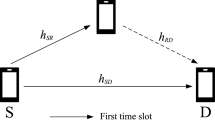Abstract
A novel multi-relay cooperative communication strategy based on Jackson queuing model is proposed, which is implemented via a cross-layer design between the physical (PHY) layer and the medium access control (MAC) layer. In the PHY layer, we focus mainly on system outage performance by analyzing in detail the relationship between the SNR threshold and the outage probabilities. While in the MAC layer, system model is treated as a Jackson queuing network, and the queue discipline for each node is assumed to be GI/M/1 model. System throughput and delay performance for the proposed strategy are also illustrated. Simulation results of the proposed cross-layer scheme are presented to validate our theoretical derivations. It is revealed that, the number of cooperative nodes influences system outage performance at high spectral efficiency regimes in the PHY layer while the proposed strategy provides a better throughput and delay performance than conventional schemes in the MAC layer.
Similar content being viewed by others
References
Sendonaris A, Erkip E, Aazhang B. User cooperation diversity, part I/II: System description/implementation aspects and performance analysis. IEEE Trans Commun, 2003, 51: 1927–1948
Laneman J N, Tse D N C, Wornell G W. Cooperative diversity in wireless networks: efficient protocols and outage behavior. IEEE Trans Inf Theory, 2004, 50: 3062–3080
Azarian K, Gamal H E, Schniter P. On the achievable diversity-multiplexing tradeoff in half-duplex cooperative channels. IEEE Trans Inf Theory, 2005, 51: 4152–4172
Lin R, Petropulu A P. Cooperative transmission for random access wireless networks. In: Proc. of 2005 International Conference on Acoustics, Speech and Signal Processing (ICASSP 2005). Philadelphia, USA, 2005. 373–376
dek A K, RayLiu K J, Ephremides A. Cognitive multiple access via cooperation: protocol design and performance analysis. IEEE Trans Inf Theory, 2007, 53: 3677–3696
Bletsas A, Khisti A, Reed D P, et al. A simple cooperative diversity method based on network path selection. IEEE J Select Areas Commun, 2006, 24: 659–672
Dimic C, Nicholas D S, Zhang R F. Medium access control-physical cross-layer design. IEEE Signal Process Mag, 2004, 21: 40–50
Srivastava V, Motani M. Cross-layer design: a survey and the road ahead. IEEE Commun Mag, 2005, 43: 112–119
Chen X L. Queuing Theory in Modern Communications (in Chinese). Beijing: Publishing House of Electronics Industry, 1999. 47–51, 63–67
Liu Q W, Zhou S L, Giannakis G B. Queuing with adaptive modulation and coding over wireless links: cross-layer analysis and design. IEEE Trans Wirel Commun, 2005, 4: 1142–1153
Author information
Authors and Affiliations
Corresponding author
Rights and permissions
About this article
Cite this article
Xu, X., Zheng, B. novel multi-relay cross-layer cooperative communication strategy based on Jackson queuing model. Sci. China Inf. Sci. 53, 842–853 (2010). https://doi.org/10.1007/s11432-010-0029-5
Received:
Accepted:
Published:
Issue Date:
DOI: https://doi.org/10.1007/s11432-010-0029-5




